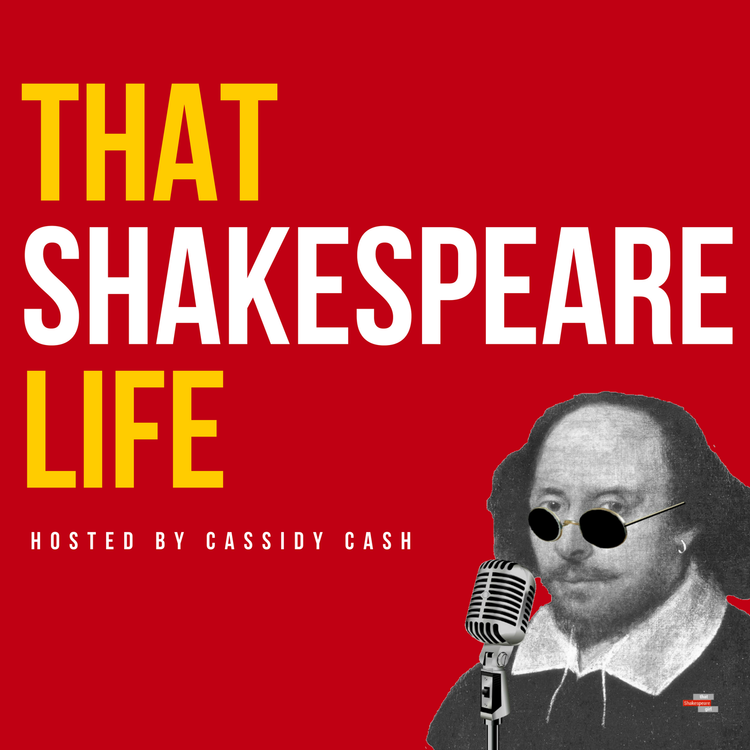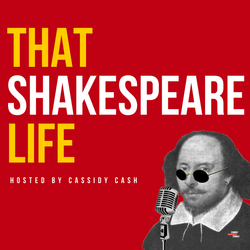Share

That Shakespeare Life
Doors, How They Were Built, and Designed
Ep. 344
•
Shakespeare has all kinds of references to doors in his works, at least 195 instances of the actual word “door” in fact, and for many of us, we probably gloss over the word ‘Door” thinking we understand what he’s talking about. However, architectural history tells us that doors were actually quite different for Shakespeare’s lifetime than what we have today from how they were made, to how they were constructed, and even how they were locked. Our guest this week, James Campbell is an expert in architectural history and joins us today to help us understand more about what doors were like in the 16-17th century including what kind Shakespeare might have had on his house.
More episodes
View all episodes

343. Gamut, a Musical Scale for the 16th Century
29:13||Ep. 343All 4 of Shakespeare’s references to the word “gamut” show up in his play Taming of the Shrew where the characters talk about learning, and teaching, the “gamut.” If you’ve ever heard the expression “run the gamut” or “cover the gamut” these expressions are based on an 11th century understanding of the word “gamut” developed by the musician and monk named Guido d'Arezzo, who used the term to described a whole range of notes. While there was no national standard of education in England for Shakespeare’s lifetime, knowing about music, how to play, and scales like that of D’Arezzo, were considered a sign of nobility, which is the cultural perspective Shakespeare utilizes when he puts a gamut in his play. Here today to share with us the history of the gamut, the 16th century musicians contemporary with Shakespeare that might have influenced the musical scenes of this play, as well as what exactly is meant by the phrase “run the gamut” is our guest and professor at the O’Neill Hall of Music at the University of Notre Dame, Alexander Blachly.
342. The Gunpowder Plot
43:54||Ep. 342Tomorrow night, November 5, is when many in England will celebrate an occasion known as Bonfire Night. They celebrate this day to mark the moment King James I was saved from the Gunpowder Plot (along with many in his government) when Guy Fawkes was thwarted in his attempt to blow up England’s Parliament using gunpowder hidden beneath the building during an official government meeting. The event was a terrorist attack of the 17th century, to put the plot in contemporary terms, and the aftermath in England impacted William Shakespeare personally. Newly minted as the King’s Men in 1603, the gunpowder plot is taking place just two years later, in 1605. Just one month after the Gunpowder Plot in December of 1605, Shakespeare writes King Lear, which contains many nods to the state of James’ government, but the real play most connected to The Gunpowder Plot has to be Macbeth, which I argue was the play whose performance would silence all doubt about William Shakespeare’s involvement, or suspected treasonous connections, in the aftermath of The Gunpowder Plot of 1605. Here today to walk us through the history of this event, and help us understand how the Gunpowder Plot connected to Shakespeare, is our guest, James Travers.
341. Witch Trials During Shakespeare’s Lifetime
33:49||Ep. 341Shakespeare made the three witch sisters famous in his play, Macbeth, by showcasing their manupulative power, encantations, and their famous pot of double double toil and trouble. While this version of witches makes for a fun spoof at Halloween parties today, when Shakespeare was originally bringing these sisters to life on stage, witches were not only considered real beings, but were thought to be clandestine actors, hiding their real identity behind normal appearances so as to be better position themselves to inflict harm on others. Everything from natural disasters to household accidents could be blamed on this kind of magic, and seemingly innocuous actions like speaking sharp words, having the wrong birthmark, or sometimes just owning the wrong kind of house pet, could all land people, and women in particular, in a fight for their lives at a witch trial where they were often hopelessly charged with proving their innocence against charges of witchcraft. Many of these individuals stories have been lost to history, or relegated to a list of names on an accusation list, but our guest this week seeks to bring the real life stories of actual women who were tried as witches to the fore with her latest book titled Witchcraft: A History in Thirteen Trials that takes a look at 13 specific witch trials from the 16-18th centuries. Here today to help us understand the history of how someone would find themselves accused of witchcraft, what was involved in the process of an official witch trial, and the real events blamed on witchcraft that had a powerful influence on King James I of England, who wrote his publication titled “Daemonology” just a couple of years before Shakespeare wrote Macbeth, is expert in the history of witches, and return guest to our show, Dr. Marion Gibson.
340. Revenge Plays, Madness, Murder, and Ghosts
27:55||Ep. 340Revenge Tragedy is a genre of plays, applied posthumously to Shakespeare's works. Just like modern day film and tv has genres like romance, western, or comedy, plays of Shakespeare’s lifetime had these categories, too, and today we're going to explore a particular subcategory of tragedy known as Revenge Tragedies. While the genre itself didn't exist in Shakespeare's lifetime, the plays and what they are known for, were a very popular form of entertainment in both Elizabethan and Jacobean England. In fact, many consider Shakespeare’s Hamlet to the best example of Revenge Plays from this period. We are delighted to welcome back to the show Rhona Silverbush and Sami Plotkin to talk with us the ghosts, madness, and other spooky elements that constituted a good revenge play, what made them so popular for Shakespeare’s lifetime, and which playwrights in addition to Shakespeare, were penning this category into history for the 16th and 17th century.
339. Night Walking, Link Boys, and Artificial Light
29:06||Ep. 339In 1552, a lexicographer gave us the word “noctivagation” which means walking around at night. The word itself was a legal term for Shakespeare’s lifetime, used to describe someone that wandered around at night without any particular purpose. Vagrancy, on the whole, was frowned upon for Shakespeare’s lifetime, but vagrancy at night was viewed with extreme suspicion. In fact, walking around at night illegitimately was so bad that in his play King Lear, Shakespeare implies that the poster boy for night walkers is Satan himself. This negative understanding of nightwalkers gets confusing though, when we consider Falstaff in Henry IV talks about walking from tavern to tavern at night with Bardolph, and mentions it as fun, certainly not anything they were worried about, and other period references from the 16th century talk about Link Boys, who were young boys paid to escort travelers as night while carrying a torch to light the way. What does this mean about travelling at night in a city like London? Were there legitimate reasons to be out after dark, and what options were available for creating artificial light prior to the advent of the light bulb? Here today to answer these questions and introduce us to the concept of night walkers, and night lights, for Shakespeare’s lifetime is our guest, Matthew Beaumont.
338. Collaboration and Influence on Shakespeare's Plays
56:54||Ep. 338When Shakespeare was writing plays in the 16th to early 17th century, he was participating in an industry that was both established, as well as rapidly evolving. Shakespeare himself ushered in innovation for the theater industry, while the bard, along with his contemporaries, equally embraced long held traditions that included shamelessly copying one another’s work. Acknowledging that copying someone’s work was industry standard for Renaissance England raises some questions about plagiarism, as well as who should get the credit for writing a particular story. Our guest this week, Darren Freebury Jones, has visited with us before to look at the influences of Thomas Kyd and even Robert Greene on the works of William Shakespeare, and Darren is back again this week to share with us the theater industry he has uncovered for his latest book, Borrowed Feathers, where he uses you’ll remember we called “textual sleuthing” in an earlier episode, to examine production, influence, authorship, and collaboration amongst playwrights such as Lyly, Kyd, Fletcher, and of course, Shakespeare. We are delighted to welcome Darren back to That Shakespeare Life again this week to talk with us about what it looked like to be a colleague in the theater industry for the 16th century, what constituted industry standard when you were writing plays, and how much influence a modern lens looking backwards at history has had on what we think we know about how Shakespeare produced his works.
337. Beavers Extinct in England by the 16th Century
30:49||Ep. 337In Henry IV Part 1, Vernon refers to the clothing of young Harry saying “I saw young Harry, with his beaver on…” There are at least 6 other references to the large, semi-aquatic rodent known as the beaver to be found in Shakespeare’s plays, and while many of Shakespeare’s references are talking about the helmet feature that opens and closes on the front of soldier’s face, the references are a reflection of the animal beaver that had been plentiful in the UK right up until Shakespeare’s lifetime, when they had been hunted for their fur, meat, and castoreum, a substance produced by their anal scent glands that was used in products like perfume. While beavers were once native to Britain, they were hunted to extinction during the 16th century, and have only recently started to be reintroduced to the UK. Our guest this week, Lee Raye, joins us to talk about the journey from native species to extinction for the beaver, how that impacted commerce and the landscape of England during Shakespeare’s lifetime, and to update us on the efforts to reintroduce the beaver to the UK that have been taking place recently.
336. Beaver Pelts Used for Everything From Hats to Medicine
33:10||Ep. 336During Shakespeare's lifetime England, along with other European nations, began intentional exploration to the New World, where they not only established colonies but established commerce relationships with the native tribes they found there. Exchanges in what the Dutch West India Company called ‘New Netherland’ included trades of beaver pelts and shell beads with tribes like the Algonquian Indians, who you may remember from our episodes on Squanto, Samoset, and The establishment of Fort Raleigh. Our guest this week has done an indepth project into the trade, commerce, and diplomatic relationships between Europeans and the native tribes of the New World, specifically looking at how beaver pelts (which were hugely popular in England for the 16-17th century) were traded and used for everything from hats to medicine. We are delighted to welcome Molly Leech to the show today to help us understand the role of wampum in Shakespeare’s history.